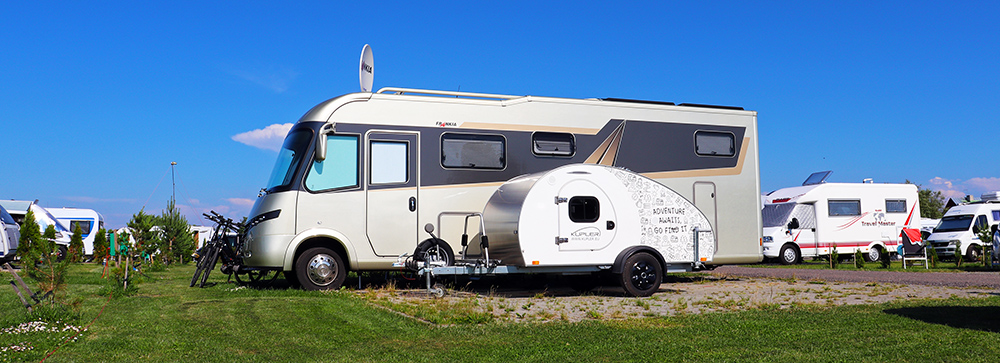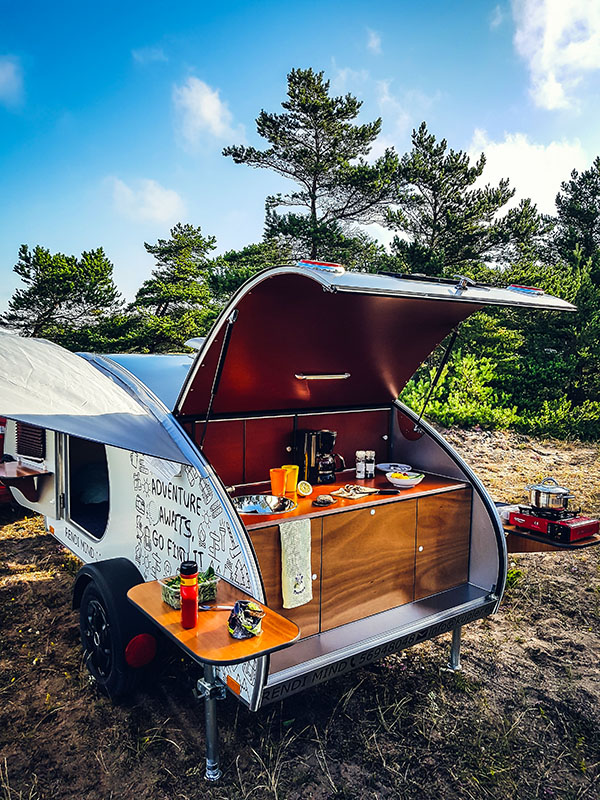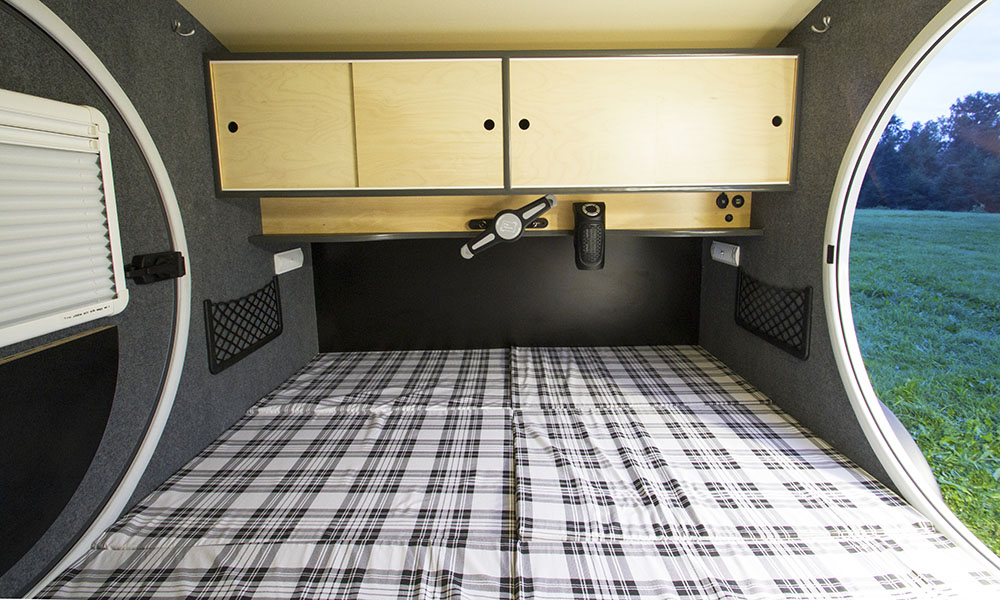Category: Blog
Teardrop campers (also known as a teardrop caravan and teardrop trailer) were very popular back in the days in the USA, but they almost disappeared for decades when more powerful cars and bigger caravans entered the market combined with cheap fuel prices. In recent years, the popularity of teardrop trailers has been on the rise again in different continents, and more and more people are finding this type of mini caravan to be the perfect fit for them. So what are the advantages of a teardrop camper that have caused its resurgence?
Advantages of a Teardrop Camper
Lightweight and easy to tow
Teardrop campers are small and light; therefore, there is no need for heavy-duty car to tow it. Mini caravans can be towed by just about any car as long as it has a hitch. So there is a good chance the car you already own has the power to tow a teardrop camper.
The small size of teardrop campers also makes them easy to manoeuvre. Whether it’s navigating through tight spaces when getting fuel, parking at overcrowded spots or manoeuvring between trees at the campsite – all this can be done stress-free.
The small weight and size of the teardrop camper also makes reversing easier. And if you ever find yourself stuck with seemingly no way back or forward, you can always unhitch your mini caravan and push it to the right position yourself. It probably won’t even make you sweat.
Affordable
Most teardrop trailers cost significantly less than bigger caravans. And the lightweight and aerodynamic, low profile design of teardrop trailer ensures that the fuel consumption of the towing vehicle is only minimally affected. So not only are teardrop campers less expensive, they are also economical to run.
Low Maintenance
Teardrop campers don’t need much maintenance. They have a compact design and functionality with fewer systems and moving parts onboard that can potentially fail, in comparison to bigger caravans. This ensures low upkeep costs, adding another element to the cost effectiveness of owning a teardrop camper.
Easy to Store
Teardrop campers are small and therefore don’t take up much space. Most teardrops easily fit in a garage, driveway or parking spot. This means you can store your caravan at home and there is no need to use vehicle storage facilities and pay for storage. If you store your teardrop camper on your premises, you can even use it as a guest bedroom when you have visitors staying overnight.

Versatility
Because teardrop trailers are small, lightweight and easy to tow, they can go to many places bigger caravans and motorhomes can’t. With a teardrop mini caravan, you can access remote areas and take advantage of the most scenic sites.
Even at campgrounds, bigger caravans are often forced to stay in flat spots as the trees could damage the caravan. With a teardrop camper, this kind of issue doesn’t really crop up and nothing is there to prevent you from choosing the most picturesque spot.
Customisable
Most teardrop campers are easy to customise to make truly your own. You can custom design the exterior to express your personality, opt for bigger tires which give more ground clearance, have a roof rack for kayaks, canoes, surfboards, etc. There are also many third-party add-on options available such as tents, roof tents, awnings, etc. that can be added to teardrop campers to extend their space.

Smaller Carbon Footprint
As the fuel consumption of the towing vehicle doesn’t increase significantly when hauling a mini caravan, then this means a lower carbon footprint compared to bigger caravans and motorhomes. It also takes less resources to produce a little teardrop caravan, which in turn has less impact on the environment.
Appealing Design
Teardrop trailers have an iconic design. They look cosy and cute and far more appealing than box-shaped caravans and motorhomes. It’s safe to say that the design of the teardrop trailer is a big contributing factor to their popularity.

Being close to nature
A teardrop camper encourages you to be in nature. You use the cabin mostly for sleeping and do your cooking outdoors. So you really feel you are part of nature. Bigger caravans and motorhomes, on the other hand, can encourage you to spend more time inside as they tend to be houses on wheels with the same distractions and temptations as at home.
Easy set up
As all the camping gear can be stored in a teardrop camper, it’s very easy to get out and go in the matter of minutes. Once you are at the campsite, set up (and later take down) doesn’t take longer that 10-15 minutes. While your campsite neighbour with a bigger caravan is still busy with manoeuvring and unhooking, you can already relax and enjoy the great outdoors.
More comfortable than a tent
Teardrop campers are an upgrade from a tent by offering more comfort yet still keeping you close to nature. You have a comfortable bed and don’t have to sleep on rough or uneven ground. You are also protected from the elements by the sturdy walls and roof, staying cosy and warm inside.
Similar to bigger caravans, the advantage compared to a tent is also the set up and take down time. This can be big hassle with a tent, while the set up of a teardrop camper barely takes any time. Teardrop campers also offer more security. When leaving the campsite, a teardrop camper can simply be locked up and your possessions are safe while you are away.
Bigger from inside than outside
Teardrop campers are small and this is a fact. From the outside, it might look there is not much space for anything. But you may be surprised when you go inside. It actually feels more spacious from inside than outside. As teardrop campers are small, many smart solutions are used to create more space. One solution for example is underfloor storage compartments that give extra space for the gear you bring along.

Light travel
As teardrop trailers are small, despite all the smart solutions the space is still limited. But we see this as a positive thing. You only take with you the things you actually need and don’t overpack. This also makes packing and unpacking a much quicker and easier process.
If nevertheless you need to take more things with you, there is always the option to use your towing vehicle to store some of the things as well as the add-on options of a roof rack and storage boxes, which will extend the available space even further.
Resale value
Teardrop campers are less expensive than bigger caravans and motorhomes. They also have fewer systems and moving parts that can potentially fail, so they hold their resale value very well.
A teardrop camper is a great option for those who love nature and are looking for a small, affordable, easy to maintain caravan with plenty of other advantages. Hopefully, the benefits we have described above will help you consider whether a teardrop camper is a good match for you. If yes, Kupler would be more than happy to build one for you. Contact us to join Kupler family.
Kupler mini caravan has a special design and is known as a teardrop caravan (also teardrop camper or teardrop trailer). A teardrop caravan is a streamlined, compact and light travel trailer with a sleeping cabin and kitchenette in the rear. It derives its name from the unique teardrop contour, as it comprises a large curved front that tapers towards the back of the caravan, reminiscent of a teardrop. It’s a great concept and although we would like to take credit for that, teardrop campers have been around for much longer than you might think. In the following article, we will give you a brief overview of the history of caravanning and teardrop caravans in particular.
How Did Caravanning Start
The origins of travel caravans and caravanning can be traced back to nomadic people such as the European Romani and travelling showmen and women who spent most of their lives on horse drawn caravans. However, they travelled more out of necessity than leisure. The first recorded recreational caravan was built in 1880 in the UK. The purpose of this caravan was to go on holiday and the owner later published a bestselling book about his adventures on the road. So the idea of caravanning caught on among people. But back then caravans were the ultimate luxury items and were exclusive to the wealthy upper class. Nevertheless, by the turn of the century, caravanning for leisure had become an increasingly popular activity and in 1901, the first dedicated caravanning club was established in the UK.
As cars started to replace horse drawn carriages, caravans also evolved. In 1919, the first car-towed caravan entered commercial production in the UK. By the early 1920s, the interest in caravanning had also spread in the United States. But it was still wealthy people’s playground, as caravanning was naturally restricted to those who had the funds to own a car and a caravan. It was only in the 1930s when caravanning came within the financial reach of the middle class, and this is when caravanning as we know it today really began.
When Did Teardrop Caravan Enter the Picture
The teardrop caravan dates back to the 1930s and originated from the US. It is very difficult to say when exactly the first teardrop caravan was built and who that brilliant man (or woman) was who came up with the concept, but the proven fact is that they already existed in 1936. It is believed that the teardrop caravan was actually born out of necessity in the Great Depression era, when people would build these caravans for affordable shelter and for relocation in search of a job.
In 1936, an article on how to build a teardrop caravan was published in a magazine, and the years that followed saw many more such articles along with detailed building plans. These articles and plans were meant for do-it-yourselfers and inspired many people to build their own teardrop caravan in their backyards.
Teardrop caravans slowly began to gain popularity, but then World War II put them on hold. People had other things in mind than building a teardrop, and from 1940 to 1946 there is no known history/articles about building teardrop caravans. But then, once the war was over, teardrop caravan became extremely popular in the United States. The war had given the economy a large boost and American families had the surplus income to go on holidays again. The teardrop camper became especially appealing, as it was lightweight and could easily be towed by a family car, which in the 30s and 40s had a small engine with less than 100 horse power. The road network was also becoming well developed with more and more paved roads, which made travelling easier than ever before.
The true beginning of teardrop caravan mania is credited to an article in Mechanix Illustrated magazine from 1947 titled “Trailer for Two”. The concept of this article was a low cost do-it-yourself and it came with extensive building plans. This helped to boost teardrop caravan popularity a great deal.
Post-war teardrop caravans were often built from leftover and salvaged materials from World War II. In some cases, salvaged wheels from war jeeps were used as the teardrop caravan wheels and the exterior layers were crafted from bomber plane aluminium wings, giving it a shiny look. However, plywood was the main building material.
There were many do-it-yourselfers out there, but teardrop caravans were also commercially produced. In 1945, Kit Manufacturing Co was established to start the commercial production of teardrop caravans. The initial idea was to produce kits that people could assemble themselves but this concept proved not to be a success for them. Soon the owners realised what people wanted was not a kit, but rather a completed caravan, and they decided to produce teardrop caravans in completed form.
The first public showing of Kit Manufacturing teardrop caravans was held in February 1946 at Gilmore Stadium in L.A. They presented 12 completed units and booked 500 orders on site. What a success! But that was just the beginning. A few months after that first presentation they were operating in two shifts and turning out 40 caravans a day. In 1946 and 1947, they produced 4,500 teardrop caravans in total. Any teardrop caravan manufacturer today would be over the moon with these kinds of sales. The success of Kit Manufacturing Co paved the way for others and it’s believed there were about 35 teardrop caravan manufacturers in the United States from 1945 to 1961.
The popularity of teardrop caravans continued until the late 1950s. After that it started to decrease and teardrop caravans completely disappeared from mainstream camping in the mid-1960s. As cars were getting bigger and more powerful in the 50s, they could also tow larger campers and caravans. In an era when petrol was cheap and bigger was better, teardrops quickly declined in popularity and had to make way for bigger and more luxurious recreational vehicles that could fit the whole family.
Rebirth of the Teardrop Caravan
For decades teardrop caravans were forgotten but as many fashion trends have made a comeback, so too has the teardrop caravan. And we mainly have the internet to thank for that. In the late 1990s, many old teardrop caravan do-it-yourself plans reappeared online and have been picked up by enthusiasts wanting to build caravans for their vintage cars or small vehicles. Nowadays, there are also many commercial providers offering ready-made teardrop campers. So it’s safe to say teardrops are gaining in popularity again, and although much has changed since they were first introduced, the reasons for owning one have remained somewhat the same. They can be towed by the small cars many people drive today, and they are very economical as fuel consumption is only minimally affected. That means a lot considering modern petrol prices.
Teardrop caravans were relatively unknown in Europe while they were hugely popular across the pond all those decades ago, but that has changed now. This simple and inexpensive form of travelling and camping is appealing to more and more people around the world. Are you one of them? Check out our teardrop caravan to see if Kupler could be your future travel companion.